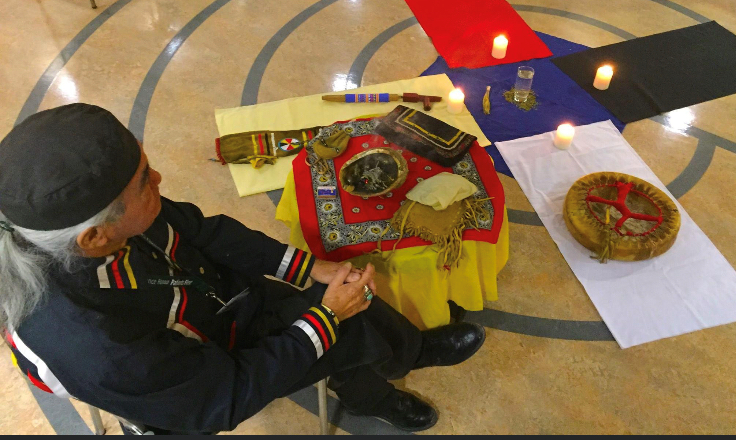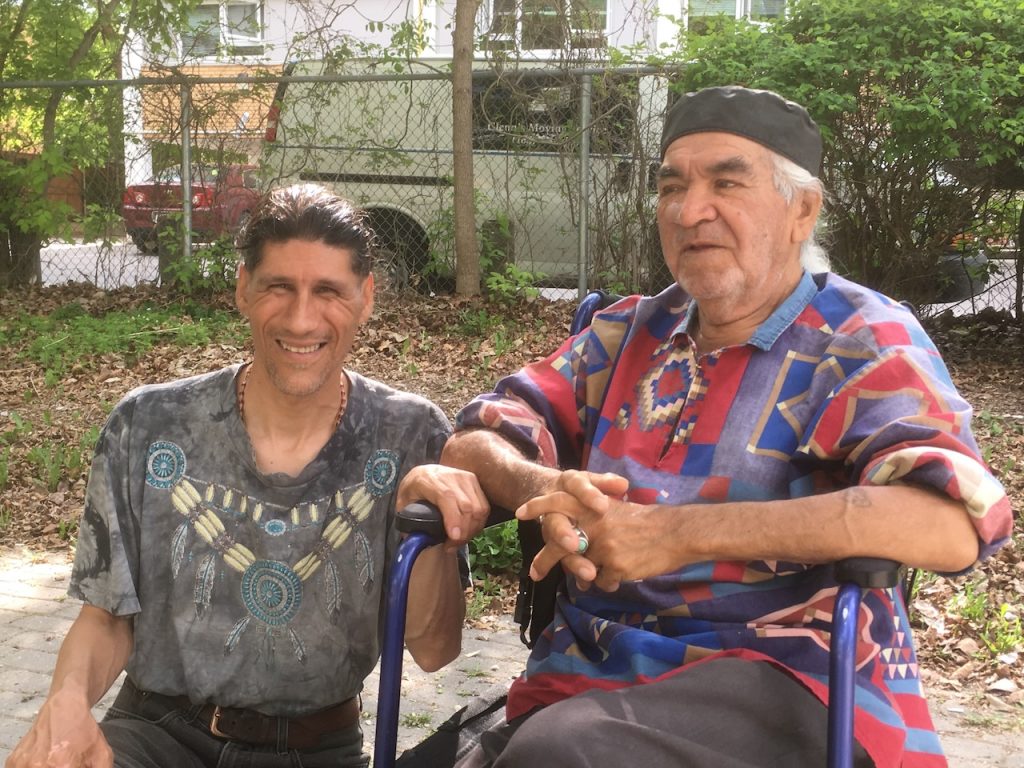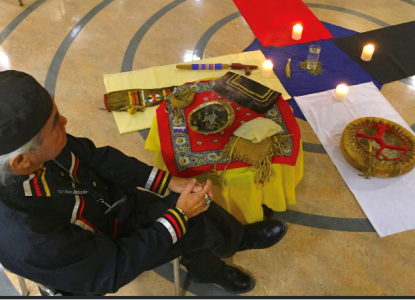Indigenous elder brought ceremony to life
By Doug Koop
– – –
When construction began on the Canadian Human Rights Museum, Indigenous and Metis elders conducted ceremonial rituals as each piling was about to be pounded into the ground.
Roger Armitte was among those who brought medicine bags filled with sage, sweetgrass, tobacco and cedar to put into each hole as a sign of respect for the earth, thanking her for her sacrifice and seeking forgiveness for putting a hole into her. At the time, I referenced him in an article about the persistence of spiritual ritual in a material society.

A few years later, I got to know him as a colleague when I joined the Spiritual Health department at HSC Winnipeg. On an orientation tour, he and I encountered a confused patient waiting fearfully in the hallway to be transferred for a test. Roger paused to acknowledge the dread in the man’s eyes. Within a minute he was speaking in one of his several languages, cadences that to my ear echoed those of the Lord’s Prayer. When the words were done, his hand scribed a few sweeping gestures in the air.
Roger had a way of moving seamlessly between his spiritual traditions as an Indigenous man and the Roman Catholic religion in which he was raised, and within whose tutelage the young lad suffered abuse.
“You know when I made what looked like the sign of the cross,” he volunteered as we moved on, “I was acknowledging Creator in the four directions.”
On another occasion, Roger and I ran into a person he knew (which seemed to happen all the time). This patient was living with a debilitating malaise that doctors were having difficulty diagnosing and was convinced the problem was otherworldly. He wanted a ceremony to clear the way so healing could occur.
“He believes he’s under a curse,” said Roger, wondering if I understood the concept, and was satisfied that I had an inkling.
Roger died in hospital on January 20. He was 75.
Quest to overcome
Life was never easy for Roger. From the fragments of biography I picked up in the years our lives intersected, his boyhood was pocked with unsavoury moments and he suffered continuously from a painful, damaged leg. Later, he lived with difficult dynamics in his own family, and limped throughout his life.
Yet he managed to find his vocation as a healer and went on to hold all manner of interesting positions. He served in hospitals and prisons, for example, and as elder-in-residence at the University of Manitoba. He interacted with fascinating people and conducted countless ceremonies. He participated in a ritual to welcome to the “sacred” white bison, Blizzard, at the Assiniboine Park Zoo.
A couple years after his retirement, Roger was in the hospital to have the problematic leg amputated. He wept at the impending loss even as he welcomed its promised release from pain. He also noted the symbolic significance of shedding this souvenir of the bullying that had caused so much childhood consternation.
The wounded leg was an enduring reminder of woes, a vulnerability that heightened his sensitivity to the suffering of others and nurtured the tender kindness he characteristically brought as a salve. Roger could be fragile, and his own distresses would sometimes surface. Yet he often exuded Yoda-like calm in compassionate companionship with hurting souls. With drums, medicines, pipes, songs, rituals, and prayers he was a harbinger of healing.
Deeply wounded himself, he cared immensely for others.
Survivor
Roger is not the only residential school survivor whose final days are filled with nightmare images of grim oppression. With Roger (and others), I have observed accomplished seniors shivering in stark terror as the institutional ambience of the hospital triggers revolting memories of long ago. The hurts of the child are multiplied in the man.
They may have worked for decades to overcome the detritus of early experience, developing wholesome reputations, and modelling for many a better way to live. But when the darkness of the past descends, these mature and respected elders can be reduced to fragile bodies quivering in abject fear. Their hands reach out for solace, clinging with a desperate grip as the ghosts of torments past envelope them like an avalanche.
To perish in the soul-space is unbearable. As an observer, simply to bear witness to the horror of an abused eight-year-old reliving itself in the wizened body of an elder is an emotional challenge; to live with it an inescapable nightmare. Indeed, the late-life re-emergence of juvenile agony amplifies the crippling discomfort: To the suffering of early years is added the futility of a lifetime spent seeking to move through and beyond the travails of a sullied childhood.
It’s a mercy that the dying experience often arrives with welcome consolations. Habitual attitudes and postures can re-assert themselves when the terrors fade.
Roger’s last days provided a roller coaster ride of humour and pathos, wisdom and fear, tears and laughter, foolishness and faith. Curious, isn’t it, that in these situations where evil and mortality are on full display, confidence in the goodness of Creator persists? Though anxieties temporarily overwhelm, the prospect of a spiritual transformation shines a timely beacon.
A former mentor of mine facing his own dire diagnosis said he was trying to listen to the advice he’d often given to others: “Don’t ditch in the darkness what you learned in the light.”

D-Day
On the morning of the day he died Roger was clear and full of questions. He’d had an awful go of it the day before and knew in his soul that he’d begun his final “journey.”
“Am I dying?” he asked.
“That’s what I’ve been told.”
“When?”
“Who knows? I don’t.”
“Sooner? Or later?”
“Probably sooner.”
“How soon?”
Big pause. “Days to weeks rather than weeks to months,” I offered. We let that sink in, mercifully unaware that Roger’s release from his body was scant hours away.
“Is it okay if I cry?” I had to ask.
He nodded approval and together we wept. Tears gently trickled through the furrows and stubble of his face while mine soaked softly into a mask.
On the morning of the day he died, Roger spoke of the reunions with loved ones he anticipated on the other side. He reviewed his life, beginning with birth in “beautiful Ste. Rose du Lac” and ending in a hospital bed in a place where he’d worked and sung the “Travelling Song” for countless others. Now he wanted a drummer to come to companion him home.
In Roger’s acquittal of his life, he registered but one regret: He did not want to be separated from Andy, his love for 18 years. He yearned to be with his partner and dreaded to think how Andy would feel, how he would fare on his own. Again, we wept.
Throughout the years I visited Roger as a patient, I’d often come with a Bluetooth speaker and a playlist of tunes. Inevitably he would request Leonard Cohen’s “Hallelujah,” for it soothed his soul like no other song (and very few prayers) could ever do.
I won’t be bringing music to Roger anymore, but each time I pass his more youthful image nicely displayed on HSC’s Heritage Way, I’ll pause to remember the man who suffered much and extended healing to many. And to utter my own “very broken hallelujah.”
– – –
Doug Koop is a Winnipeg-based Spiritual Health Practitioner and freelance writer.


